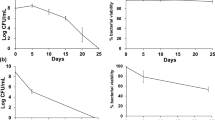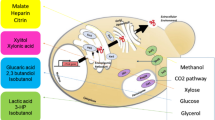Abstract
We describe the isolation of a gene ( clxA) encoding calnexin from laboratory and industrial strains of Aspergillus niger. Calnexin is a chaperone, which specifically recognises monoglucosylated glycoproteins in the endoplasmic reticulum, and is thus an essential component of the process that assesses the folded state of nascent secreted glycoproteins. Manipulation of chaperones has previously been adopted in attempts to overcome some of the problems associated with the secretion of heterologous proteins from filamentous fungi. The A. niger clxA gene encodes a 562-residue protein with strong homology to the calnexin of Schizosaccharomyces pombe. The clxA gene product complements a S. pombe cnx1 mutant. Motifs associated with genes controlled via the Unfolded Protein Response (UPR) were identified by sequence homology in the promoter of clxA. Steady-state levels of clxA mRNA were elevated in a strain expressing bovine prochymosin fused to the catalytic domain of glucoamylase. The ORF is punctuated by four introns, and contains two sets of four repeated peptide motifs that are characteristic of the calnexin family, together with a putative membrane-spanning domain. Deletion studies indicate that clxA is not an essential gene in A. niger.




Similar content being viewed by others
References
Archer DB (2000) Filamentous fungi as microbial cell factories for food use. Curr Opin Biotechnol 11:478–483
Archer DB, Peberdy J (1997) The molecular biology of secreted enzyme production by fungi. Crit Rev Biotechnol 17:273–306
Archer DB, Jeenes DJ, MacKenzie DA, Brightwell G, Lambert N, Lowe G, Radford SE, Dobson C (1990) Hen egg-white lysozyme expressed in, and secreted from, Aspergillus niger is correctly processed and folded. Biotechnology 8:741–745
Ballance DJ, Turner G (1985) Development of a high-frequency transforming vector for Aspergillus nidulans. Gene 36:321–331
Becker DM, Guarente L (1991) High efficiency transformation of yeast by electroporation. Methods Enzymol 194:182–187
Brown AJP, Lithgow GJ (1987) The structure and expression of nuclear genes in Saccharomyces cerevisiae. In: Kinghorn JR (ed) Gene structure in eukaryotic microbes. IRL Press, Oxford, pp 1–26
Chang SC, Erwin AE, Lee AS (1989) Glucose-regulated protein (GRP94 and GRP78) genes share common regulatory domains and are coordinately regulated by common trans-acting factors. Mol Cell Biol 9:2153–2162
Chen W, Helenius J, Braakman I, Helenius A (1995) Cotranslational folding and calnexin binding during glycoprotein synthesis. Proc Nat Acad Sci USA 92:6229–6233
Conesa A, Jeenes DJ, Archer DB, van den Hondel CAMJJ, Punt P (2002) Calnexin overexpression increases manganese peroxidase production in Aspergillus niger. Appl Env Microbiol 68:846–851
Corbett EF, Michalak M (2000) Calcium, a signaling molecule in the endoplasmic reticulum. Trends Biochem Sci 25:307–311
Cox JS, Chapman RE, Walter P (1997) The unfolded protein response coordinates the production of endoplasmic reticulum protein and endoplasmic reticulum membrane. Mol Biol Cell 8:1805–1814
De Virgilio M, Kitzmuller C, Schwaiger E, Klein M, Kreibich G, Ivessa NE (1999) Degradation of a short-lived glycoprotein from the lumen of the endoplasmic reticulum: the role of N-linked glycans and the unfolded protein response. Mol Biol Cell 10:4059–4073
Dorner AJ, Krane MG, Kaufman RJ (1988) Reduction of endogenous GRP78 levels improves secretion of a heterologous protein in CHO cells. Mol Cell Biol 8:4063–4070
Dorner AJ, Wasley LC, Kaufman RJ (1992) Overexpression of GRP78 mitigates stress induction of glucose regulated proteins and blocks secretion of selective proteins in Chinese hamster ovary cells. EMBO J 11:1563–1571
Dunn-Coleman NS, et al (1991) Commercial levels of chymosin production by Aspergillus. Biotechnology 9:976–981
Ellgaard L, Helenius A (2001) ER quality control: towards an understanding at the molecular level. Curr Opin Cell Biol 13:431–437
Gouka RJ, Punt PJ, van den Hondel CAMJJ (1997) Efficient production of secreted proteins by Aspergillus: progress, limitations and prospects. Appl Microbiol Biotechnol 47:1–11
Gurr SJ, Unkles SE, Kinghorn JR (1987) The structure and organisation of nuclear genes in filamentous fungi. In: Kinghorn JR (ed) Gene structure in eukaryotic microbes. IRL Press, Oxford, pp 93–139
Harmsen MM, Bruyne MI, Raué HA, Maat J (1996) Overexpression of binding protein and disruption of the PMR1 gene synergistically stimulate secretion of bovine prochymosin but not plant thuamatin in yeast. Appl Microbiol Biotechnol 46:365–370
Hebert DN, Foellmer B, Helenius A (1995) Glucose trimming and reglucosylation determine glycoprotein association with calnexin in the endoplasmic reticulum. Cell 81:425–433
Hebert DN, Foellmer B, Helenius A (1996) Calnexin and calreticulin promote folding, delay oligomerisation and suppress degradation of influenza hemagglutinin in microsomes. EMBO J 15:2961–2968
Helenius A, Trombetta ES, Hebert DN, Simons JF (1997) Calnexin, calreticulin and the folding of glycoproteins. Trends Cell Biol 7:193–199
High S, Lecomte FJL, Russell SJ, Abell BM, Oliver JD (2000) Glycoprotein folding in the endoplasmic reticulum: a tale of three chaperones? FEBS Lett 476:38–41
Hoffmann CS, Winston F (1987) A ten-minute DNA preparation from yeast efficiently releases plasmids for transformation of E. coli. Gene 57:267--272i
Jannatipour M, Rokeach LA (1995) The Schizosaccharomyces pombe homolog of the chaperone calnexin is essential for viability. J Biol Chem 270:4845–4853
Jeenes DJ, Pfaller R, Archer DB (1997) Isolation and characterisation of a novel stress-inducible PDI-family gene from Aspergillus niger. Gene 193:151–156
Kim PS, Arvan P (1995) Calnexin and BiP act as sequential molecular chaperones during thyroglobulin folding in the endoplasmic reticulum. J Cell Biol 128:29–38
Korman DR, Bayliss FT, Barnett CC, Carmona CL, Kodama KH, Royer TJ, Thompson SA, Ward M, Wilson LJ, Berka RM (1990) Cloning, characterisation, and expression of two α-amylase genes from Aspergillus niger var. awamori. Curr Genet 17:203–212
Lis JT, Xiao H, Perisic O (1990) Modular units of heat shock regulatory regions: structure and function. In: Morimoto RI, Tissières A, Georgopoulous C (eds) Stress proteins in biology and medicine, Cold Spring Harbor Laboratory Press, Cold Spring Harbor, New York, pp 411–428
Maundrell K (1993) Thiamine-repressible expression vectors pREP and pRIP for fission yeast. Gene 123:127–130
Molinari M, Helenius A (2000) Chaperone selection during glycoprotein transport into the endoplasmic reticulum. Science 288:331--333
Moralejo FJ, Watson AJ, Jeenes DJ, Archer DB, Martín JF (2001) A defined level of protein disulfide isomerase expression is required for optimal expression of thaumatin by Aspergillus awamori. Mol Genet Genomics 266:246–253
Moreno S, Klar A, Nurse P (1991) Molecular genetic analysis of fission yeast Schizosaccharomyces pombe. Methods Enzymol 194:795–823
Mori K, Sant A, Kohno K, Normington K, Gething M, Sambrook JF (1992) A 22 bp cis -acting element is necessary and sufficient for the induction of the yeast KAR2 (BiP) gene by unfolded proteins. EMBO J 11:2583–2593
Ngiam C, Jeenes DJ, Archer DB (1997) Isolation and characterisation of a gene encoding protein disulphide isomerase, pdiA, from Aspergillus niger. Curr Genet 31:133–138
Ngiam C, Jeenes DJ, Punt PJ, van den Hondel CAMJJ, Archer DB (2000) Characterisation of a foldase, protein disulfide isomerase A, in the protein secretory pathway of Aspergillus niger. Appl Env Microbiol 66:775–782
Parlati F, Dignard D, Bergeron JJM, Thomas DY (1995a) The calnexin homologue cnx1 + in Schizosaccharomyces pombe, is an essential gene which can be complemented by its soluble ER domain. EMBO J 14:3064–3072
Parlati F, Dominguez M, Bergeron JJM, Thomas DY (1995b) Saccharomyces cerevisiae CNE1 encodes an endoplasmic reticulum (ER) membrane protein with sequence similarity to calnexin and calreticulin and functions as a constituent of the ER quality control apparatus. J Biol Chem 270:244–253
Patil C, Walter P (2001) Intracellular signalling from the endoplasmic reticulum to the nucleus: the unfolded protein response in yeast and mammals. Curr Opin Cell Biol 13:349–356
Punt PJ, Dingemanse MA, Kuyvenhoven A, Soede RDM, Pouwels PH, van den Hondel CAMJJ (1990) Functional elements in the promoter region of the Aspergillus nidulans gpdA gene encoding glyceraldehyde-3-phosphate dehydrogenase. Gene 93:101–109
Punt PJ, van Biezen N, Conesa A, Albers A, Mangnus J, van den Hondel C (2002) Filamentous fungi as cell factories for heterologous protein production. Trends Biotechnol 20:200–206
Raeder U, Broda P (1985) Rapid preparation of DNA from filamentous fungi. Lett Appl Microbiol 1:17–20
Robinson AS, Wittrup KD (1995) Constitutive overexpression of secreted heterologous proteins decreases extractable BiP and protein disulfide isomerase levels in Saccharomyces cerevisiae. Biotechnol Prog 11:171–177
Robinson AS, Hines V, Wittrup KD (1994) Protein disulfide isomerase overexpression increases secretion of foreign proteins in Saccharomyces cerevisiae. Biotechnology 12:381–384
Robinson AS, Bockhaus JA, Voegler AC, Wittrup KD (1996) Reduction of BiP levels decreases heterologous protein secretion in Saccharomyces cerevisiae. J Biol Chem 271:10017–10022
Roderick H, Lechleiter JD, Camacho P (2000) Cytoplasmic phosphorylation of calnexin controls intracellular Ca2+ oscillations via an interaction with SERCA2b. J Cell Biol 149:1239-1247
Rothstein R (1991) Targeting, disruption, replacement and allele rescue: integrative DNA transformation in yeast. Methods Enzymol 194:281–301
Roy B, Lee AS (1999) The mammalian endoplasmic reticulum stress response element consists of an evolutionarily conserved tripartite structure and interacts with a novel stress-inducible complex. Nucleic Acids Res 27:1437–1443
Sambrook J, Fritsch EF, Maniatis T (1989) Molecular cloning: a laboratory manual (2nd edn). Cold Spring Harbor Laboratory Press, Cold Spring Harbor, New York
Sousa M, Parodi AJ (1995) The molecular basis for the recognition of misfolded glycoproteins by the UDP-Glc:glycoprotein glucosyltransferase. EMBO J 14:4196–4203
Tatu U, Helenius A (1997) Interactions between newly synthesised glycoproteins, calnexin and a network of resident chaperones in the endoplasmic reticulum. J Cell Biol 136:555–565
Van Gemeren IA, Punt PJ, Drint-Kuyvenhoven A, Broekhuijsen MP, van't Hoog A, Beijersbergen A, Verrips CT, van den Hondel CAMJJ (1997) The ER chaperone-encoding bipA gene of black Aspergilli is induced by heat shock and unfolded proteins. Gene 198:43–52
Van Hartingsveldt W, Mattern IE, van Ziejl CM, Pouwels PH, van den Hondel CA (1987) Development of a homologous transformation system for Aspergillus niger based on the pyrG gene. Mol Gen Genet 206:71–75
Vassilakos A, Michalak M, Lehrman MA, Williams DB (1998) Oligosaccharide binding characteristics of the molecular chaperones calnexin and calreticulin. Biochemistry 37:3480–3490
Wang H, Ward M (2000) Molecular characterization of a PDI-related gene prpA in Aspergillus niger var. awamori. Curr Genet 37:57–64
Ward M, Kodama KH, Wilson LJ (1989) Transformation of Aspergillus awamori and A. niger by electroporation. Exp Mycol 13:289–293
Ward M, Wilson LJ, Kodama KH, Rey MW, Berka RM (1990) Improved production of chymosin in Aspergillus by expression as a glucoamylase-chymosin fusion. Biotechnology 8:435–440
Ward M, Wilson LJ, Kodama KH (1993) Use of Aspergillus overproducing mutants, cured for integrated plasmid, to overproduce heterologous proteins. Appl Microbiol Biotechnol 39:738–743
Williams DB (1995) Calnexin: a molecular chaperone with a taste for carbohydrate. Biochem Cell Biol 73:123–132
Acknowledgments
This work was partly funded by an EC Biotechnology programme grant, BIO2 CT-942045 (D.J.J., D.B.A., J.F.P). J.E. was supported by a Biotechnology and Biological Sciences Research Council CASE-studentship. This work has been carried out in compliance with the current laws governing genetic manipulation in the U.S.A and the UK
Author information
Authors and Affiliations
Corresponding author
Additional information
Communicated by C. A. M. J. J. van den Hondel
Rights and permissions
About this article
Cite this article
Wang, H., Entwistle, J., Morlon, E. et al. Isolation and characterisation of a calnexin homologue, clxA, from Aspergillus niger . Mol Gen Genomics 268, 684–691 (2003). https://doi.org/10.1007/s00438-002-0790-2
Received:
Accepted:
Published:
Issue Date:
DOI: https://doi.org/10.1007/s00438-002-0790-2




